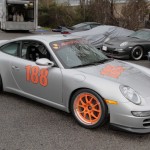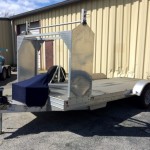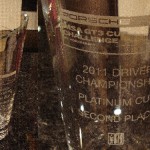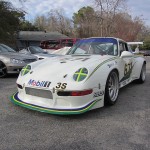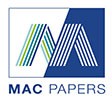Sequential Transmissions and Paddle Shift
Porsche GT3 Cup cars have featured sequential shifters since the introduction of the 997 GT3 Cup in 2006 (Supercup in 2005). Though they are more common and understood now than they were in 2006, there are still some misconceptions about traditional sequential transmissions.
A typical racecar with sequential transmission will feature the same clutch and pedal as an H-pattern equipped car, and it can be used in identical ways. On most sequentials, the shifter mechanism contains a strain gauge, and when the shifter is pulled for an upshift, the ECU will cut the ignition. This cut momentarily pauses acceleration and takes all load off the driveline. In this fraction of a second, the gear change can be completed and power resumed. Because there is no load on the driveline, the clutch is not needed, and since this is facilitated with ignition, the throttle can be held full. Full-throttle, no-clutch upshifts should be performed as quickly as possible to minimize wear.
Downshifts are performed exactly as they are in an H-pattern transmission. The clutch and rev-matching blip should be employed to minimize wear. There are no synchros in a Porsche sequential box, so rev-matching is even more important than in a synchronized H-pattern transmission. It is common on 997 cups to use a throttle blipper to remove that component of the downshift from the driver’s responsibilities. Even with a throttle blipper, the clutch should be disengaged to ensure smooth downshifts. Using a clutch is more critical than an H-pattern box because there is no neutral in between gears to use for rev-matching; however, there is a moment (though very small) where the transmission is in-between gears, and a rev-match can be squeezed in. It is physically possible to downshift without the clutch, but it will increase wear and be unforgiving. It is likely to cause instability and transmission damage, and it is not recommended.
The 2013 (Supercup only until 2014) 991 GT3 Cup and some of the production Porsches use paddle-shift, but the systems are very different. From a driver standpoint, both will seem very similar, but mechanically, they are nothing alike. The cup has a conventional single-clutch sequential transmission (though an entirely new unit from the 997, but the same fundamental function). It needs the same clutch and blip as the 997 cup, but it is all performed automatically by an ECU controlled pneumatic system. The production cars use a PDK dual-clutch transmission. It is not a true sequential, as any gear can be engaged at any time. Odd number gears (1st, 3rd and 5th) transmit power through one clutch and the even number gears through the other. One clutch will be engaged and the other disengaged. Two gears (one on each clutch) will be simultaneously selected, and to change from one to the next, the engaged clutch will disengage, and the other will engage. This means gears are always selected under no load and is very good on transmission life, but a bit harder on the clutches.
